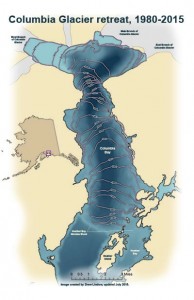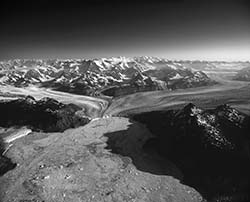By Alan Sorum
Council Project Manager

Columbia Glacier, located in the Chugach Mountains of Alaska, is losing mass faster than almost any other glacier in the state. Columbia is a tidewater glacier, a type of valley glacier that flows into the ocean.
In 1996, the council began a project to monitor and analyze the calving and drift of ice from the glacier, through Columbia Bay, and into Prince William Sound. The ice sometimes drifts into the established tanker shipping lanes. Loaded tankers leave their designated lanes to avoid this ice.
In 2012, the council began to update information developed in the original 1996 project to determine the future risk of Columbia Glacier icebergs to the tanker traffic. Funded by the council, researchers W. Tad Pfeffer and Shad O’Neel studied several aspects of ice loss at Columbia Glacier.
The study found that icebergs discharged by the glacier during the retreat have largely been contained within the moraine shoal, located at the position of the terminus prior to the glacier’s retreat. The fraction of icebergs that cross the moraine and enter Prince William Sound proper still pose a potential hazard to ship traffic in the Sound.
